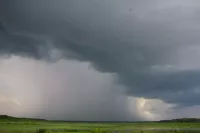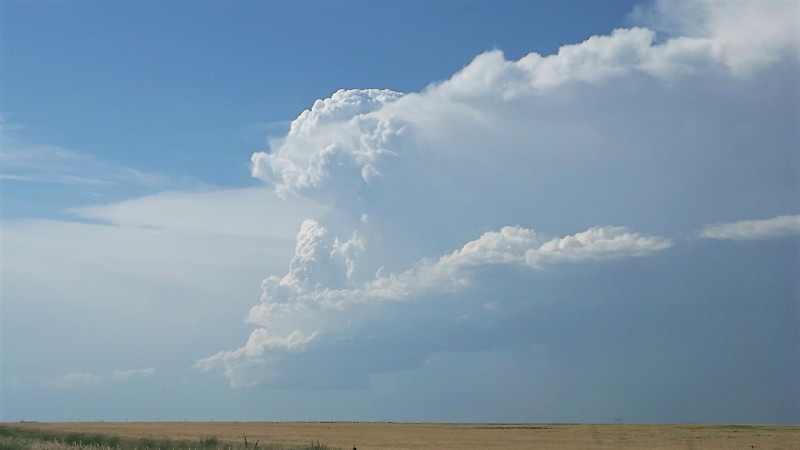A supercell is a type of thunderstorm distinguished by a mesocyclone, a rotating updraft. These storms are the least common but most severe type of thunderstorm. Often isolated, supercells can control local weather conditions up to 20 miles away and typically last for 2-4 hours.
September 20, 1926: F4 tornado strikes Encarnación
On September 20, 1926, an F4 tornado struck the city of Encarnación, Paraguay, killing over 300 people, making it the second deadliest tornado in South America.
1947: Supercell hits Sydney
On New Year's Day in 1947, a supercell hit Sydney, Australia. The classic type Supercell formed over the Blue Mountains and impacted the lower CBD and eastern suburbs. At the time, it was the most severe storm to strike the city since recorded observations began in 1792.
1959: First supercell storm identified
In 1959, the Wokingham storm over England was the first storm identified as a supercell. It was later studied by Keith Browning and Frank Ludlam in 1962.
1962: Study of Wokingham storm
In 1962, Keith Browning and Frank Ludlam studied the Wokingham storm, which had been identified as a supercell in 1959. Browning's work contributed to the modern conceptual model of supercells.
January 10, 1973: San Justo tornado
On January 10, 1973, the San Justo tornado, located 105 km north of the city of Santa Fe, Argentina, was rated F5, making it the strongest tornado ever recorded in the southern hemisphere, with winds exceeding 400 km/h.
1974: 1974 Super Outbreak
The 1974 Super Outbreak spawned over 10 violent tornadoes, killed over 300, and caused billions in damage, most of which can be attributed to tornado damage.
June 3, 1980: Grand Island tornado outbreak
The Grand Island tornado outbreak affected the city of Grand Island, Nebraska on June 3, 1980. Seven tornadoes touched down in or near the city that night, killing 5 and injuring 200.
April 13, 1993: Largest tornado outbreak in South America
On April 13, 1993, less than 24 hours in the province of Buenos Aires was given the largest tornado outbreak in the history of South America. There were more than 300 tornadoes recorded, with intensities between F1 and F3.
April 14, 1999: Severe supercell storm in New South Wales
On April 14, 1999, a severe storm later classified as a supercell hit the east coast of New South Wales, Australia. It dropped an estimated 500,000 tonnes of hailstones and caused approximately A$2.3 billion worth of damage, making it the most costly disaster in Australia's insurance history at the time.
December 2000: Series of tornadoes affect Greater Buenos Aires
In December 2000, a series of twelve tornadoes affected the Greater Buenos Aires and the province of Buenos Aires, causing serious damage. One of them struck the town of Guernica.
January 2001: F3 tornado devastates Guernica
In January 2001, just two weeks after a tornado in December 2000, an F3 tornado again devastated Guernica, killing 2 people.
December 26, 2003: Tornado F3 in Cordoba
On December 26, 2003, an F3 tornado with winds exceeding 300 km/h hit Córdoba Capital, Argentina, killing 5 people and injuring hundreds.
2004: EF3 tornado hits Palmital
In 2004, an EF3 tornado hit the city of Palmital, State of São Paulo, destroying several industrial buildings and 400 houses, killing four and wounding 25.
July 2005: Mumbai deluge
In July 2005, Mumbai, India experienced a deluge believed to be caused by a supercell. 944 mm of rain fell, with 700 mm falling in just four hours, coinciding with a high tide which exacerbated conditions.
February 27, 2007: Supercell hits Canberra
On February 27, 2007, a supercell hit Canberra, Australia, dumping nearly 39 centimeters of ice in Civic. The weight of the ice caused a shopping center roof to collapse, killed birds, and stranded people.
June 22, 2007: Elie, Manitoba tornado
The Elie, Manitoba tornado was an F5 that struck the town of Elie, Manitoba on June 22, 2007. While several houses were leveled, no one was injured or killed by the tornado.
August 3, 2008: Supercell forms over northern France
During the evening of August 3, 2008, a supercell formed over northern France, spawning an F4 tornado in the Val de Sambre area which impacted nearby cities. This same supercell later generated other tornadoes in the Netherlands and Germany.
May 2009: Strong Supercell Storm in South Africa
In May 2009, a strong supercell storm was observed in South Africa, indicated by a hook echo on local radars and satellite imagery. The storm brought heavy rains, winds, and large hail to the area.
November 2009: Tornadoes reach Posadas
In November 2009, four tornadoes, rated F1 and F2, reached the town of Posadas, Argentina, generating serious damage in the city. Three of the tornadoes affected the airport area.
2009: Supercell over Belgium
In 2009, on the night of Monday May 25, a supercell formed over Belgium, causing significant damage. An incredible 30,000 lightning flashes were recorded in 2 hours. In Lillo a loaded goods train was blown from the rail tracks.
March 2010: Supercell storms hit Melbourne
In March 2010, supercell storms hit Melbourne, Australia, causing flash flooding and hailstone damage to cars and buildings. The storms caused more than $220 million in damage and sparked over 40,000 insurance claims. 19 mm of rain fell in just 18 minutes, flooding streets and disrupting transportation.
March 22, 2010: Supercell hits Perth
On March 22, 2010, a supercell hit Perth, causing hailstones of 6 centimeters in size and torrential rain. The city received its average March rainfall in just seven minutes, leading to severe property damage and over 100 million dollars in damage.
May 24, 2010: Supercell in eastern Germany
On May 24, 2010, an intense supercell left behind a trail of destruction spanning across three different states in eastern Germany. It produced multiple strong downbursts, damaging hail and at least four tornadoes, most notably an F3 wedge tornado which struck the town of Großenhain, killing one person.
October 2, 2011: Devastating Tornadoes Hit South Africa
On October 2, 2011, two EF2 tornadoes struck separate parts of South Africa. The first hit Meqheleng, near Ficksburg, causing significant damage and one fatality. The second hit Duduza, Nigel, also causing devastation and two fatalities.
2011: 2011 Super Outbreak
In 2011, the Super Outbreak occurred, during which many tornado outbreaks originated from clusters of supercells. Large supercells spawned multiple long-tracked and deadly tornadoes.
April 4, 2012: Storm Buenos Aires
On April 4, 2012, Gran Buenos Aires was hit by the storm Buenos Aires, with intensities F1 and F2, which left nearly 30 dead in various locations.
June 28, 2012: Supercells affect England
On June 28, 2012, three supercells affected England. Two of them formed over the Midlands, producing hailstones reported to be larger than golf balls. Another supercell produced a tornado near Sleaford, in Lincolnshire.
March 23, 2013: Bangladesh tornado
On March 23, 2013, a massive tornado ripped through Brahmanbaria district in Bangladesh, killing 20 and injuring 200. The supercells in this region often produce high winds with hail and occasional tornadoes.
May 2013: Series of tornadoes devastate Oklahoma City
In May 2013, a series of tornadoes caused severe devastation to Oklahoma City. From May 18 to May 21, a series of tornadoes hit, including a tornado which was later rated EF5, which traveled across parts of the Oklahoma City area, causing a severe amount of damage in a heavily populated section of Moore.
May 31, 2013: Widest tornado on record hits El Reno
On the night of May 31, 2013, another eight deaths were confirmed from what became the widest tornado on record which hit El Reno, Oklahoma, one of a series of tornadoes and funnel clouds which hit nearby areas.
July 28, 2013: Long-lived supercell in southern Germany
On July 28, 2013, an exceptionally long-lived supercell tracked along an almost 400 km long path across parts of Baden-Württemberg and Bavaria in southern Germany. The city of Reutlingen was hit the hardest. It was the costliest thunderstorm event ever documented in Germany.
December 8, 2013: Severe storms in Argentina
On Sunday December 8, 2013, severe storms took place in the center and the coast of Argentina. The most affected province was Córdoba, storms and supercells type "bow echos" also developed in Santa Fe and San Luis.
February 21, 2014: Tornado in Berazategui
On February 21, 2014, in Berazategui, Argentina, a tornado of intensity F1 caused material damage to a car with two occupants inside.
November 27, 2014: Supercell hits Brisbane
On November 27, 2014, a supercell hit the inner city suburbs including the CBD of Brisbane. Hailstones up to softball size cut power to 71,000 properties, injured 39 people, and caused a damage bill of $1 billion AUD. A wind gust of 141 km/h was recorded at Archerfield Airport.
May 24, 2016: Tallest Non-Tropical Thunderstorm Recorded in Mexico
On May 24, 2016, the tallest non-tropical thunderstorm on record occurred near Nueva Rosita, Coahuila, Mexico. The storm reached a height of 68,000 ft (12.9 mi; 21 km) and produced lightning as far as 50–60 mi (80–97 km) from the center.
July 2019: Supercell in northern England
On 25 July 2019 a supercell thunderstorm affected northern England and parts of Northumberland. Large hail, frequent lightning and rotation were reported by many people.
September 2020: Supercell affects West Yorkshire
On 24 September 2020 a supercell thunderstorm affected parts of West Yorkshire. The event was similar to the one in July 2019.
June 24, 2021: F4 tornado in Czech Republic
On June 24, 2021, a supercell produced an F4 tornado in south Moravia, Czech Republic, causing 6 deaths and more than 200 injuries. It was one of the costliest tornadoes to occur outside of the United States.
Mentioned in this timeline
The United States of America is a federal republic located...
India officially the Republic of India is located in South...
Germany officially the Federal Republic of Germany is a Western...
Africa is the second-largest and second-most populous continent comprising of...
Australia officially the Commonwealth of Australia encompasses the Australian mainland...

Thunderstorms also known as electrical or lightning storms are characterized...
Trending
2 months ago Dan Lanning Criticizes Big Ten Schedule Favoritism Before Oregon's Game Against Penn State.

7 minutes ago Dustin Johnson Attributes Winless Season to Split, Updates LIV Golf Teammates

3 days ago Cambridge Dictionary names 'parasocial' word of the year, inspired by Swifties and AI.
1 month ago Russian Airstrikes in Ukraine Kill Six, Putin-Trump Talks Shelved Amid Escalation.

1 hour ago Michael Douglas and Catherine Zeta-Jones Celebrate 25 Years of Marriage with Throwbacks
5 months ago Stocks Rebound Amid Israel-Iran Conflict; Dow, Nasdaq, and S&P 500 Rise.
Popular

XXXTentacion born Jahseh Dwayne Ricardo Onfroy was a controversial yet...

William Franklin Graham III commonly known as Franklin Graham is...

Cristiano Ronaldo often nicknamed CR is a Portuguese professional footballer...

Candace Owens is an American conservative political commentator and author...

Michelle Obama is an American attorney author and former First...

Marjorie Taylor Greene known as MTG is a far-right American...
